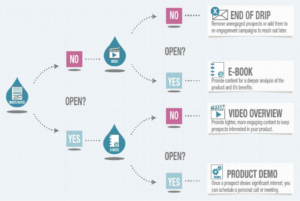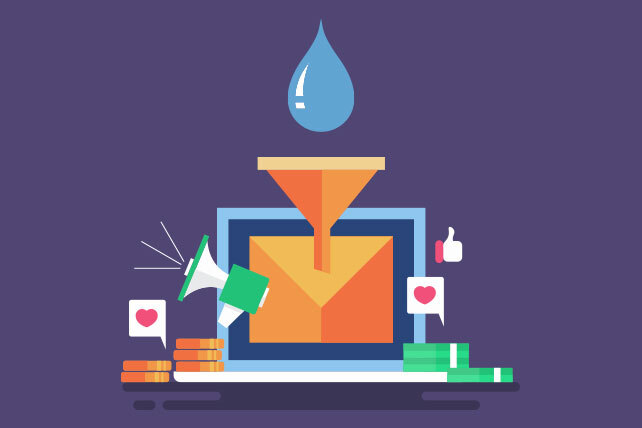Here’s what you need to know about running a drip campaign and how drip campaigns can help you re-engage customers, build relationships, and continue growing a qualified audience.
What Is a Drip Campaign?
There are a number of different names for a drip campaign you may have heard already—automated email sending, autoresponders, marketing automation, and drip marketing.
Most drip campaigns happen through email automation software, making setting up the “drip” campaign itself a pretty simple process.
But what is a drip? It’s that annoying droplet of water that drips out of your tap in the middle of the night. It’s small enough to notice and big enough that you need to take action.
An email drip campaign is similar. It’s simply sending out a series of emails, usually based on an action your customer or reader has already taken. You set up a drip campaign so when a trigger event happens, that subscriber or action-taker then receives a series of follow-up emails based on the schedule you’ve set.
These emails are delivered to the person’s inbox without you needing to do anything more. That’s why they’re also called autoresponders or automated email sending. All you do is set up the series of emails, and the email software does the rest.
Drip campaigns are most successful with personalized content. So, ensure the follow-up emails your recipients receive are personal and based on an action they took. For example, if the person clicked on an article or took a quiz, you can follow up with more detailed information about your product and how it can help the person.
When you set up a drip campaign, you get to determine the timing for each follow-up email to be distributed, whether it’s in one day or three days or a week. As you likely know, follow-up is essential to keep a person engaged with you and your brand and to strengthen the connection you’ve begun building with them.
Zapier provides this great image, which is part of a full infographic that demonstrates visually how a drip campaign works.

What Are Benefits of Using Drip Campaigns?
In November 2017, Accenture surveyed 8,000 consumers from North America and Europe about “their preferences and expectations when it comes to interacting with brands, retailers, and service providers.” What the survey found was “91% of consumers are more likely to shop with brands that recognize, remember and provide relevant offers and recommendations.”
A key benefit of using a drip campaign is recognizing and remembering the person who has engaged with you. Engaging site visitors or email subscribers using drip campaigns allows you to provide relevant offers and recommendations, otherwise known as information based on triggers, to the person. Those trigger events personalize the experience for the person even more.
A drip campaign can help you engage subscribers who haven’t engaged with your content for a while.
Using drip campaigns saves you time. Yes, that’s right, time. Why? Because rather than taking time to compose an email, finding your email list or email addresses, and making sure you’re sending the correct email to the right person — a drip campaign does all that for you, for only the time it takes to set up and write the email sequence. That’s worth it.
Another benefit is that all your new potential customers will receive the same messaging from you once they take action. Why? Because once you’ve set up a drip campaign when the trigger event occurs, a person will receive a sequence of emails, just the same as everyone else who’s taken the same action or engaged with your business in the same way.
That means you’re no longer trying to remember whether you sent a person an introductory email or delivered specific content instructions. That all happens as part of your automation sequence.
The other significant benefit of using a drip campaign is that you’re continuing, through small and steady pieces of content, the reinforcement of that valuable relationship with either a potential or existing customer.
Things Drip Campaigns Can Help With…
- Reward valuable customers by providing them with additional material or special offers for a period after the first purchase from you.
- Send specific information to someone who engages with just one page of your website. For example, the person may be looking at one particular topic or product, and you can engage more on that (and only that) specific topic.
- Deliver registration material when someone has signed up for a webinar, event or training course.
- Follow up on a customer who hasn’t bought a product or attended an event in a while.
- Restart your relationship by delivering valuable material people might find helpful based on past interactions with you.
- Send updated information on a topic the person may have been interested in previously.
- Educate users on a specific topic.
- Segment your audience even further to make personalizing your conversation even more effortless.
- Gain a better understanding whether one type of content works better for a segment of subscribers than other content.
Could a Drip Campaign Help You?
Using a drip campaign can undoubtedly help you and your customer relations efforts. The idea is to start small. Choose one area of your engagement efforts you want to improve. Next, decide how you want to change the relationship with the people in that group. Use that information to develop a series of drip emails designed to deliver the outcome you want.
For example, for people who signed up to your email newsletter and haven’t opened it for the past three months, develop a drip campaign that delivers new information they might find helpful or send some uplifting messages and useful information combined through a campaign run for a few weeks.
This will help you determine whether that subscriber wants to reignite your relationship. Based on the emails they engage with within the campaign, you may find that what they’re looking for right now is uplifting messages. You can then tailor information for them and engage on a different level.
Focusing on one engagement area and developing a drip campaign will help you see the benefits of such a campaign, both in time-savings and improved relationships. Once you’ve set up your first drip campaign, there’s no doubt you will find other areas to employ them.
